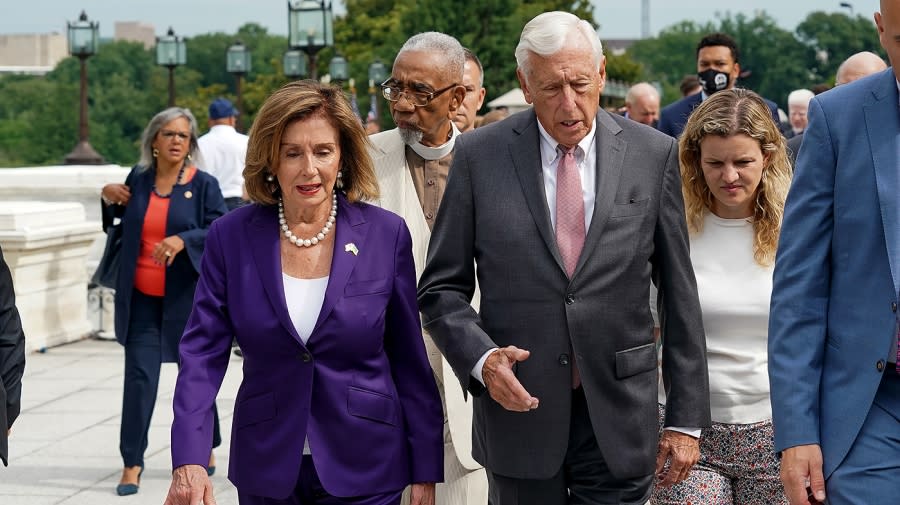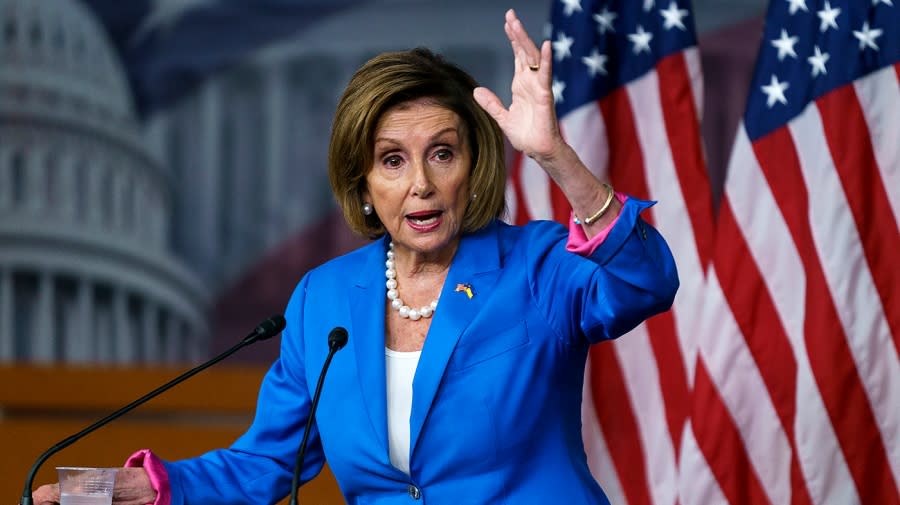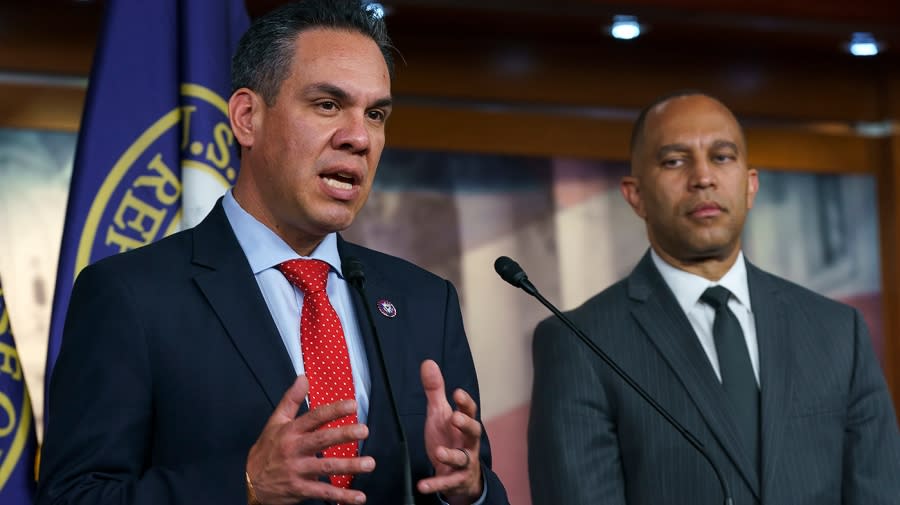Hoyer’s future hangs in limbo as likely shake-up looms in the House
- Oops!Something went wrong.Please try again later.
- Oops!Something went wrong.Please try again later.
- Oops!Something went wrong.Please try again later.
After 20 years as the No. 2 House Democrat, Rep. Steny Hoyer is facing an uncertain future.
The House majority leader has given no sign he intends to bow out of party leadership next year, marking a contrast with Speaker Nancy Pelosi (D-Calif.), who has pledged to do just that.
But with Republicans widely predicted to win control of the lower chamber in Tuesday’s elections, a younger crop of Democrats is expected to come gunning for new spots in the leadership ranks, threatening any and all of the party’s long-standing triumvirate — Pelosi, Hoyer (Md.) and Majority Whip James Clyburn (D-S.C.) — if they do seek to remain in power.
Like Pelosi and Clyburn, Hoyer has been reticent about his role in the next Congress, saying only that he’ll make his plans clear when the midterm dust settles. But lawmakers, aides and outside observers who have followed the career of the 21-term Maryland institution say they fully expect Hoyer to launch another bid to remain in the top levels of leadership, regardless of the election results.
“That’s everyone’s understanding,” said one lawmaker, who spoke anonymously to discuss a sensitive topic.
A former Democratic leadership aide was even more blunt, saying Hoyer thrives on the role he’s carved out as both a moderate dealmaker in Congress and a political “kingmaker” in Maryland — all reasons he will likely vie to stay in leadership.
“Hoyer is a guy that they’re going to have to take out on a stretcher. He is not leaving,” said the former aide.

Speaker Nancy Pelosi (D-Calif.) with House Majority Leader Steny Hoyer (D-Md.).
“The younger group is like, ‘Oh yeah, when Pelosi leaves, everybody leaves.’ But I don’t think that’s true,” the source continued. “Now, I’m not saying that Hoyer will win if they take him on. But they’re going to have to take him on.”
How Democrats perform in the midterms could prove to be the factor that ultimately determines their leadership roster next year.
Pelosi had vowed four years ago that 2022 would be her last year in a leadership role — a stipulation that helped her win the Speaker’s gavel in 2019. But if Democrats defy the odds and keep control of the lower chamber next week, some think she could remain in charge — if she chooses. That could insulate Hoyer and Clyburn, who have served together with Pelosi at the top of the party since 2006.
A red wave, by contrast, would likely spark a shake-up across the party, whetting the Democrats’ appetite for new leadership and complicating any effort by the Big Three to stay in power.
“There was some speculation that Nancy might leave early. And if that had been the case it would seem the fair thing to do to pass it to Steny for the duration of the term,” said a moderate lawmaker who has been critical of the longevity of party leaders. “But that’s a different dynamic than if we go through a bloodbath [on Tuesday]. I think people are going to be prepared for new leadership.”

Speaker Nancy Pelosi (D-Calif.).
Hoyer has emphasized that he was never a part of Pelosi’s 2018 pledge to adopt leadership term limits — a message he amplified in September, just before the House left Washington for the long midterm recess.
“She speaks for herself on that issue,” Hoyer told reporters in his Capitol office. “We’ll all make that decision, but we’re not going to make it until after Nov. 9.”
Stumping for North Carolina Democrats last month, Clyburn delivered a similar message, saying it would be “foolhardy” to talk about his future role before knowing “what the supporting cast is going to be.”
“I have no idea until this election is over,” he said. “If you’re in the majority, that’s one thing. If you’re in the minority, that’s another thing.”
Waiting in the wings are three newer members of the leadership team — Reps. Hakeem Jeffries (D-N.Y.), Katherine Clark (D-Mass.) and Pete Aguilar (D-Calif.) — who are expected to vie for the top three spots, respectively, whenever the chance arrives. And others, including Rep. Adam Schiff (D-Calif.), a prolific fundraiser, are also said to be eyeing leadership runs.
Publicly, those lawmakers are waiting patiently for post-election announcements from Pelosi, Hoyer and Clyburn — all octogenarians — before declaring their own intentions. But behind the scenes, a number of rank-and-file Democrats increasingly view Jeffries, Clark and Aguilar as the natural trio to lead the party in the next Congress, particularly if the House changes hands in next week’s midterms.

Reps. Pete Aguilar (D-Calif.) and Hakeem Jeffries (D-N.Y.).
“I’m not sure if it’ll matter if [Hoyer and Clyburn] see it as a package deal or not. I think it might very well be,” said a second Democratic lawmaker. “Because of the way the next generation of leaders are organizing themselves, that feels more like a unified effort.”
First elected in 1981, Hoyer quickly rose into the Democrats’ leadership ranks, leading the Democratic Caucus for three terms beginning in 1989 before taking on Pelosi for a vacated minority whip spot in early 2002. Pelosi prevailed, then rose the next year to become the top House Democrat, where she’s been ever since. Hoyer has been right behind her for the duration.
Over that 20-year span, Hoyer built a reputation as a moderate voice among liberal leaders, willing to reach across the aisle in search of bipartisan compromise on thorny issues like curbing deficit spending.
Those positions sometimes ruffled feathers with liberals in the caucus, particularly his vote to authorize the Iraq War, which Pelosi opposed. But he also proved himself to be an effective coalition builder, energetic campaigner and prolific fundraiser, hauling in millions of dollars each cycle and spreading it across scores of contested races.
In this cycle alone, Hoyer has visited 66 districts in 27 states, providing more than $14 million to Democratic candidates, according to his campaign office, while championing several huge pieces of legislation — including the revival of earmarks and funding to promote domestic manufacturing — signed into law by President Biden.
“He will be a contender for leadership if Pelosi doesn’t want it, and he has quite a lot of loyalty in the caucus,” said a liberal lawmaker. “He’ll be a strong contender.”
Democratic leaders are well accustomed to some controversy surrounding their long leadership tenure.
Pelosi, for years, has faced off against disgruntled lawmakers fighting to install fresh faces and ideas at the top of the party. And Hoyer and Clyburn briefly challenged each other for the No. 2 spot after Democrats lost control of the House in 2010 — a tense contest that threatened to tear the caucus along both ideological and racial lines.

Pelosi, Hoyer (Md.) and Majority Whip James Clyburn (D-S.C.).
In that case, Pelosi stepped in to defuse the frictions by creating a special leadership position, allowing Clyburn to remain the third-ranking Democrat in the minority. But some in the party are already concerned that this year’s leadership battles might turn similarly ugly, especially if Pelosi lacks the power to devise a resolution.
“There’s a lot of scenarios, but it’s going to be messy here,” said the former leadership aide.
Still other Democratic veterans agree that it’s too early to know how the leadership races will filter out. But Hoyer and Clyburn, many emphasize, have both earned the opportunity to make their pitch to remain in power.
“They seem committed to staying here a while longer, and both of them have been excellent, terrific leaders,” said Rep. Ron Kind (D-Wis.), a 13-term lawmaker who’s retiring at the end of this term.
“They certainly deserve a chance to make their case.”
For the latest news, weather, sports, and streaming video, head to The Hill.

